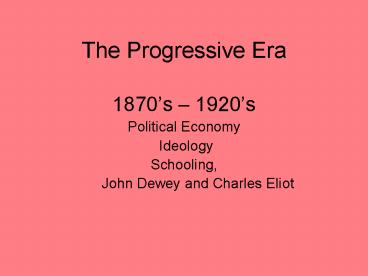The Progressive Era PowerPoint PPT Presentation
Title: The Progressive Era
1
The Progressive Era
- 1870s 1920s
- Political Economy
- Ideology
- Schooling,
- John Dewey and Charles Eliot
2
Political Economy
- Urbanization Changes
- Immigration
- increasing
- Racism and bigotry
- Industrialization
- Increase in manufacturing
- Inventions
- Scientific Management/Taylorization
- Women in more than domestic jobs
- Partnerships and Corperations formed
3
Ideology
- Modern Liberalism vs. Classic Liberalism
- Darwinism biology and relative truth
- Reason defined by scientific method experts and
organizations - Individuals viewed only as a cell in the social
organism - Progress was possible
- Government should regulate to create conditions
of freedom - People could only improve so much, they were
limited by their genetic endowment - Positive Freedom-positive government interference
- Education was for the gifted and talented only,
training was appropriate for the average and below
4
Schooling
- Progressive Education
- Response to urbanization, industrialization,
immigration and articulated in terms of the
emergent ideology of modern liberalism. - New psychological approaches.
- Traditional classical curriculum vs.
child-centered curriculum. - Emphasis on student interests and activities
related to the larger society. - Problems of the school in the 1880s
- Failure to interest and motivate students with
classical curriculum - High dropout rates
- Juvenile delinquency and illiteracy among the
urban youth growing - Waste and inefficiency in school management
practices in the neighborhood controlled schools - Irrelevance of the traditional curriculum to the
real needs of the industrial society
5
What Did Progressive Educators Believe?
- Varied curriculum based on the needs and interest
of the students - Specific concerns and motivations of each child
vs. in the best interests of the child (academic
or vocational track) - Learning should be based on activities
- School aims, content and processes should reflect
social conditions - Schools could best prepare students for
participation in a democratic society - Primary aim of school-help solve social problems
- Teacher should be resource person and guide
- Educate whole child, not just the mind
6
- Children are prepared in school as if they were
going to lead the life of slavery rather than a
life as a free individual. - John Dewey-
What do you think John Dewey meant by this
quotation?
7
John Dewey1859-1952
- John Dewey believed
- School should be a laboratory for democracy
- Children are by nature actively social creatures,
by nature constructive, creatively expressive and
finally, curious and inquiring - Classrooms should be a place where children work
together in social activity, frame and execute
their own purposes. - Schools penalize children for behaving in accord
with the above facets of nature - Working together, students could cooperatively
solve problems thinking critically about the
causes and consequences of things they were
interested in, thus growing intellectually. - Believed classroom was not preparation for life,
but life itself
8
Charles Eliot-Social Efficiency 1834-1926
-Graduated from Harvard in 1853 -Employed at
Harvard as Tutor (1854-1858) and assistant
professor of chemistry (1858-1863). He studied
chemistry and foreigneducational methods in
Europe in 1863-1865 -1869 was elected president
of Harvard University -Spokesman for the
replacement of traditional educational goals by 4
new ones 1. Social stability 2. Employable
skills 3. Equal education opportunity 4.
Meritocracy -Became and advocate of vocational
education as the numbers of ethnic diversity and
high school students increased- -Prejudices
against students not from Pure American stock
and especially against African Americans and
Indians
9
Social Stability
- Eliot was supportive of business more than labor.
- Believed one function of the school would be to
teach prospective workers a more accommodating
and cooperative attitude toward management. - Vocational education offered a good way to
address problems of labor unrest - Vocational education, night school, adult
education, supervised playgrounds, supervised
vocational guidance schools were needed. - Schooling no longer for privileged few. Now
compulsory and for mandatory many.
Employable Skills
- Schools should prepare students with specific
skills and attitudes for the workplace. - Believed society was divided into 4 groups
- Managing class 2. Commercial class
- Skilled artisans 4. Rough workers
Saw schools as factories to shape raw
materials. Increase in vocational subject
enrollment. Co-education was challenged Vocation
al subjects grew to be more than just shop and
home-ec. Now, vocational English, Vocational
Math, etc
10
Equal Education Opportunity
- Students would receive different kinds of
education, but all students would have equal
opportunity to receive the education appropriate
to them. - Teachers of the elementary schools were to sort
pupils by their evident or probable destinies.
Believed the teachers should find out what the
child does best and give them the happiness of
achievement in that line.
MeritocracyA class of persons making their way
on their own ability and talents rather than
because of class privileges The Random House
Dictionary
- Believed needed to teach students to
- 1. Respect and confide in the expert in every
field of human activity - 2. Help locate and educate the most talented
members of society for democratic leadership - IQ testing began in the second decade.
Differentiated curriculum and placement in
vocational tracks could now be based on
scientific measurement of student abilities.

